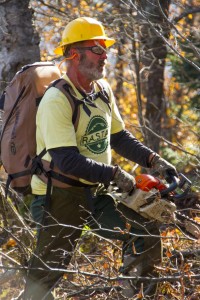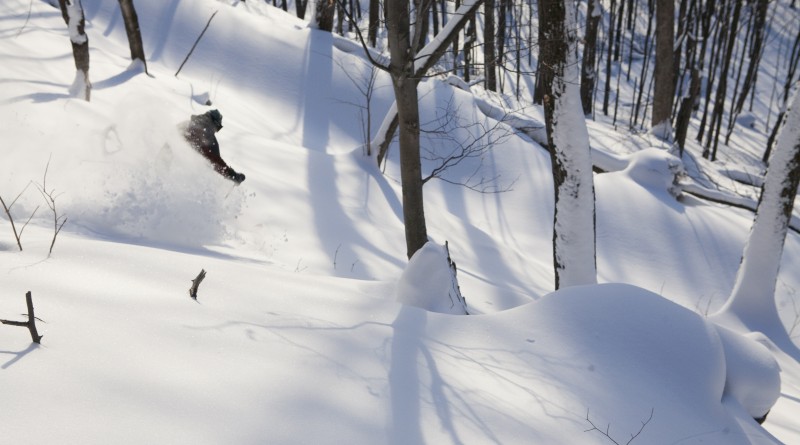Vermont’s backcountry skiers plan for the future
Photo Courtesy Vermont Backcountry Alliance/ Brian Mohr
ROCHESTER — To a hardy group of Vermonters, skiing here means far more than sticking to resorts and Nordic centers throughout the state. It also means getting out into the backcountry.
“We’re using our legs and our lungs to get around and go to those places we want to be,” Brian Mohr recently told an audience of about 150 at the second annual meeting of the newly-formed Vermont Backcountry Alliance (VTBC) held in Rochester in early November. “We’re seeing skiing come full circle and reconnecting with its homegrown, human-powered roots.”
Mohr, who has been one of a dozen or more central Vermont residents who has helped establish the alliance, said that while the number of people enjoying backcountry skiing grows, the community has a responsibility to respond.
“We’re thinking about the future and we want to take steps together as a community,” he said. “It’s a natural progression to take.”
What started a year ago at a similar meeting in Rochester has now galvanized statewide discussion around backcountry skiing. Organized early in 2014, the VTBC focuses on conserving popular areas, educating users and working with communities to develop strategies to preserve and manage backcountry terrain in Vermont. The alliance is headed by a group of backcountry-oriented skiers and riders, including Mohr, who is from Moretown; Amy Kelsey, president of the Catamount Trail Association; Jason Duquette-Hoffman, president of Worth Skis; Neil Van Dyke, search and rescue coordinator at the Vermont Dept. of Public Safety; John Egan, Chief Recreation Officer at Sugarbush Resort; and David Goodman, Waterbury-based author of multiple guide books on backcountry skiing.
But this year, the evening took a different format from the previous year. Attendees listened to presentations from landowners, the Vermont Backcountry Alliance (VTBC) and the Rochester Area Sports Trail Alliance (RASTA). They brainstormed ideas on developing backcountry skiing on state and non-state land, opportunities for economic development and possible partnerships worth exploring. They reviewed what’s happened since last year and set their sights on the season ahead. It wasn’t all work, however. The evening ended with an extensive raffle of packs, jackets and ski tickets to local mountains, while live music and dancing closed out the night.
Zac Freeman, a RASTA member who has been helping organize some of the group’s recent projects in neighboring Braintree, recalled of the first meeting a year earlier: “We were all looking at each other like deer in the headlights,” he says. “It was chaotic, but it was a moment when we realized what we each did and what our different roles were.” This year, he added, the groups are more focused on how to achieve their objectives.
One very positive development, he said, occurred in June when the Catamount Trail Association’s board of directors voted unanimously to include the VTBC as a program area of the CTA. The VTBC will coordinate backcountry programs within the CTA, which remains focused on maintaining the 300-mile long trail running the length of the state. The Rochester Area Sports Trail Alliance is the first “pilot chapter” of the CTA – a possible first step towards a chapter-based structure similar to the Vermont Mountain Biking Association or the Green Mountain Club. The work of each chapter would also be similar.
BRAINTREE MOUNTAIN FOREST

On a chilly morning this October, well before the first snows of the season fell, a group of 35 volunteers gathered on the side of a dirt road in the small town of Braintree, Vt., a few miles northwest of Randolph. Their packs were stuffed with extra layers, lunches and tools of all kinds – limb clippers, bucksaws, machetes, chain saws, cans of gasoline, protective chaps, gloves and helmets. While their skis, skins and split-boards were still at home, the group was ready for a full day of work in the woods.
Guiding the group was Paul Kendall, the local property owner, who, along with his wife Sharon Rives, donated a 1,547-acre parcel of property to the New England Forestry Foundation, a nonprofit that helps landowners preserve property. The parcel the couple donated, known as the Braintree Mountain Forest, extends west of Riford Brook in Braintree on up a ridge capped with four peaks rising to 3,030 feet, known locally (south to north) as Round Top, Double Top (or Twin Peaks), Skidoo, and 30-30.
At the top of Skidoo the volunteers set to work under the direction of Kendall, RASTA member Zac Freeman and a forester from the New England Forestry Foundation. By clearing deadfall and selectively cutting overabundant species, like striped maple or hobblebush, they created a 1,000-foot vertical drop with well-spaced trees that will make for excellent backcountry ski terrain in mid-winter.
Kendall, now 72, first came to the Braintree and the Randolph area when he was nine years old. After he and his wife moved to the area some 40 years ago, they gradually acquired more than 1,500 acres that now makes up the Braintree Mountain Forest.
Kendall’s relationship with RASTA began about a year ago when RASTA was still forming. Many of the trails Kendall had developed were across the ridgeline with little vertical descent. Kendall decided to donate the land at around the same time RASTA formed. Recognizing the opportunity to collaborate, RASTA’s Freeman worked with Kendall over the past year on a memorandum of understanding to develop three gladed skiing zones over the next five years.
“Vermont is full of local opportunities to do wonderful things,” Kendall told the audience at this year’s RASTA and VTBC meeting, crediting what he calls a “wonderful land ethic” that is built into state laws, including Act 250, current use tax law and the landowner liability law, which makes the skiers responsible for their own safety and protects landowners from possible lawsuits.
Speaking before the Rochester forum just three weeks after that first workday on Skidoo Mountain, Kendall said making the donation was a decision he was proud to make.
“When you get off I-89 at exit four for Randolph, looking west you’ll see the Braintree Mountain Range. In the middle of that is this 1,500 acres that my wife and I took 40 years to acquire because both of us share a love of the Vermont land ethic and felt that this small piece of Vermont was worth preserving for the local economy and the public.”
His remarks were met with a standing ovation.
OTHER GLADED AREAS
RASTA is also exploring four more gladed zones around Bear Brook, Chittenden Brook and Goshen Mountain, all near the Brandon Gap on Route 73. The proposed action would delineate four zones totaling approximately 210 acres and authorize selective trimming to enhance skiable terrain. These proposed developments are undergoing an impact analysis and in late November, the Green Mountain National Forest’s Rochester Ranger District invited the public to submit their comments on the proposed glade development for consideration. The public comment period is open until Dec. 19, 2014.
RASTA’s Freeman says the Forest Service can use the Braintree project as a model when considering the environmental impact of glading other areas of the forest.
“It has a similar aspect, similar ridgeline and a similar area,” he says. “That way they know what worked and what didn’t.”
As interest grows in other regions of the state, the VTBC looks to connect with communities that want to develop more local terrain and help them manage those areas responsibly. The VTBC hopes to develop strategies for areas that skiers already enjoy and pursue avenues to provide access to areas where communities would support maintaining land for backcountry skiing. Interested towns should contact Freeman or any local member of VTBC.
Other opportunities for backcountry zones include the Sepp Ruschp Trail, named after the Austrian ski instructor at Stowe Mountain Resort. In the summer before VTBC formed, the Department of Forest Parks and Recreation and the Town of Stowe restored the trail that extends north along the Sterling Ridge. Now, the opportunity exists to develop gladed zones skiers can access by way of the trail.
“That’s an example of an existing area where folks have been skiing on the trail, but perhaps there’s an interest in doing more to maintain the zone and improve the skiing there with local support,” says Mohr.
In 2015, the VTBC plans to develop a terrain management handbook similar to publications from the International Mountain Bike Association that will describe best practices for developing and maintaining backcountry skiing zones.
A SOFT OPENING
The exact locations of the glades in the Braintree Mountain Forest and the zones around Brandon Gap have not been formally announced. A trail map for the Braintree Mountain Forest is expected next year.
“We want to ease into this,” says Freeman. “We know eventually the word is going to get out. The signs are there at the trailhead and it’s only a matter of time before someone takes a picture and shares it with his or her friends. Some people will decide (backcountry skiing) is not for them, but others will keep coming back. By having this kind of soft opening, it gives us time to see how well it works.”
This summer, the VTBC also worked with the Leave No Trace Center for Outdoor Ethics to develop a code of ethics for backcountry skiing and riding. The Vermont Department of Forest Parks and Recreation, the Green Mountain National Forest and the Green Mountain Club also supplied input. The goal is to provide a list of expected behavior that can be distributed on cards at gear shops or on a sign at trailheads. The code emphasizes preparation and respect for local landowners.
As part of that effort, the alliance also teamed up with Dun Cochrane, a forester for the Green Mountain National Forest. While working on his thesis for a master’s degree, Cochrane surveyed over 500 backcountry skiers, asking them what kind of terrain they enjoyed, how often they skied and their vision for Vermont’s backcountry skiing scene.
The results of the survey indicated several areas of interest including:
- Advocating for land management from a grassroots level
- Providing backcountry zones that offer a variety of options for different user levels
- Encouraging education in backcountry safety and stewardship.
Cochrane also received thousands of comments while the survey was available online. While there was widespread support for the working group at VTBC, there was hesitation to develop too much terrain too quickly.
“A lot of people were saying that we need to strike a balance between enhancing the access, but at the same time maintaining the character of the backcountry skiing experience,” he says. “We don’t want to love it to death and create a front-country skiing experience in the backcountry.”


Pingback: Vermont Sports Magazine | Your Guide to the Outdoors in Northern New England
Pingback: Weekend report: Glade cutting with the RASTA crew - VT SKI + RIDE
Big transition to back country! I’ve been skiing for nearly 1/3 of a century, but always in bounds. No back country experience. Don’t know what to expect. What I see on YouTube makes me think I need a guide at all times. How do you get started? I live in southeastern Virginia, but drive to VT/NH every winter. Is there some way I can get hooked up?
Hi Steve,
You might want to follow our sister publication, Vermont Ski + Ride, too. Bolton Valley Resortsis a GREAT place to start as it has a backcountry center where you can rent all the gear, backcountry maps, an accessible warming hut and a big variety of terrain. Plus, because it is at elevation it tends to get a deeper snowpack earlier.
Thanks for reaching out and for reading! Lisa